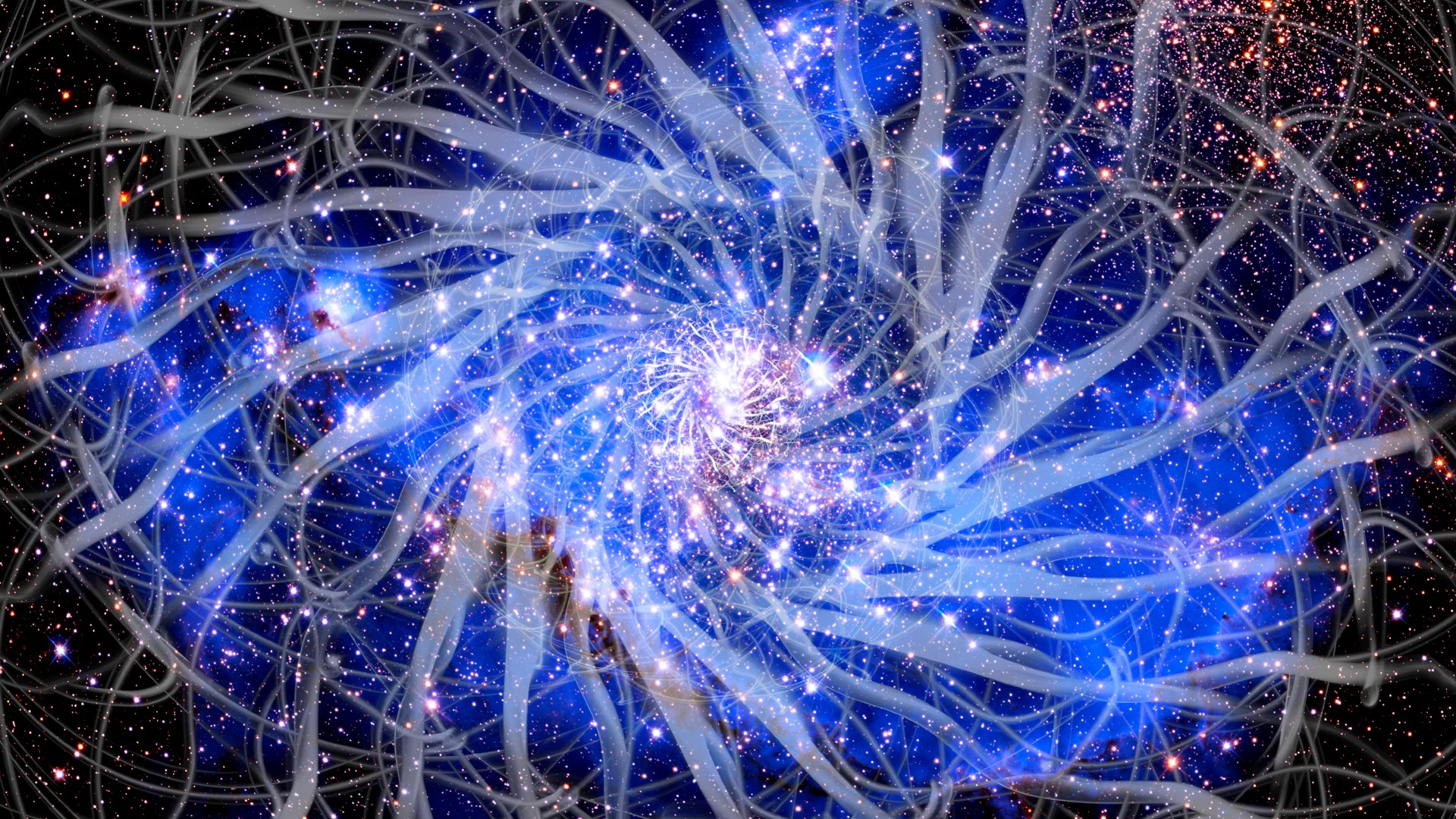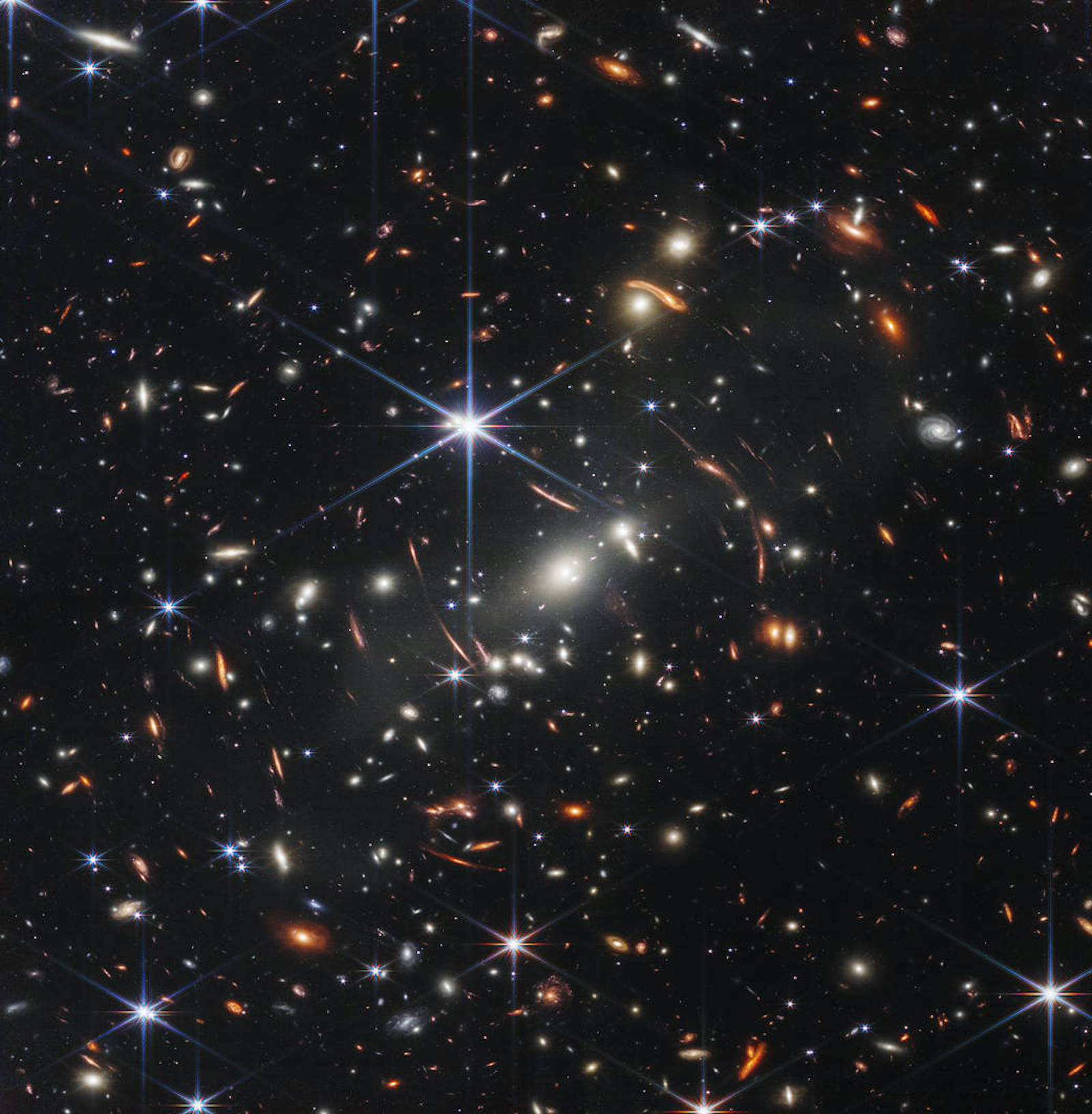Dark matter could finally reveal itself through self-interactions
One hypothesis for the nature of dark matter is that some of it could be self-interacting, meaning the individual particles interact slightly with one another.

Despite loads of circumstantial evidence for the existence of dark matter — the mysterious form of matter that dominates galaxies and clusters — astronomers have yet to make direct observations of it.
But the search is not over. One hypothesis for the nature of dark matter is that some of it could be self-interacting, meaning the individual particles interact slightly with one another. If this is true, there would be a host of subtle observational clues for the existence of this subclass of dark matter.
A few of these hints were recently outlined in a paper submitted for publication in the journal Reviews of Modern Physics and published to the preprint database arXiv.
Related: Here's how colossal galaxy clusters reveal dark matter secrets
Strong gravitational lensing
Strong lensing happens when there is a lucky coincidence of observations. When astronomers look at a distant galaxy cluster, for example, they can also see some light from even more distant galaxies passing through the cluster. The mass of the galaxy cluster (typically 10^14 or 10^15 times the mass of the sun) is so large that it bends and warps the fabric of space around it. This distorts images of background galaxies, turning them from the familiar pinwheel and elliptical structures into long, wiggly snakes and other fun shapes.
Astronomers can reconstruct those distorted images and use that reconstruction to determine how much mass is in a cluster and where it's clumped up. Typically, self-interacting dark matter has a different "clumpiness" than regular, non-interacting dark matter. Non-interacting dark matter will keep piling up to incredibly high densities in the cores of galaxy clusters, because there's nothing else there to stop it. But when dark matter interacts with itself, this slows the process of core building and smooths things out in the inner parts of a cluster.
Detailed observations (like those recently provided by the James Webb Space Telescope) of the distribution of mass inside galaxy clusters might provide a clue to the existence of dark matter.
Get the Space.com Newsletter
Breaking space news, the latest updates on rocket launches, skywatching events and more!
Weak gravitational lensing
In contrast to strong gravitational lensing, weak lensing doesn't require a massive obstruction. Instead, as the light from many distant galaxies works its way through the cosmos, the accumulated gravity of all the galaxies and other objects that the light passes near on its journey alters it in tiny ways. For example, galaxies in one particular direction may appear a bit rounder or fatter than galaxies in other directions.
Strong gravitational lensing requires lucky alignments, so we don't have a lot of clusters to work with. But even though weak gravitational lensing produces a far smaller effect, we have a lot more data to use. Astronomers are very excited for the launch of the Nancy Grace Roman space telescope, which will provide detailed weak-lensing maps of the nearby universe and might tell us if dark matter is self-interacting.

Rotation curves
In the 1970s, astronomer Vera Rubin's observations of the movement of stars inside galaxies provided the first big evidence for the existence of dark matter. In short, galaxies are spinning way too quickly. If we add up all the mass in a galaxy based on what we can see, there simply isn't enough gravity to hold on to stars with those kinds of fast orbits. Therefore, there has to be more mass that we can't see: dark matter.
Again, because self-interacting dark matter clumps up differently than non-interacting matter, this can change the rotation curves (plots of the speeds of stars at various orbits) of galaxies.
Warping of galaxies
Throughout their lifespans of billions of years, material constantly rains on every galaxy from its surroundings. In other words, every galaxy is swimming in an ocean of stuff. This material can include both regular matter and dark matter. When dark matter interacts with itself, this causes the dark matter part of a galaxy to drag slightly behind the normal matter (because the normal matter can swim through all the surrounding stuff without a problem).
This can cause galaxies to have two slightly offset cores: one made of regular matter and one made of dark matter. This offset triggers tidal disruptions throughout the galaxy, potentially even causing the disk of the galaxy to warp. Future detailed observations of galaxies may reveal a warp in the disk that only self-interacting dark matter can explain.
Mergers
When giant clusters of galaxies merge, astronomers can look at the wreckage to understand what's inside them. For example, the famous Bullet Cluster shows what happened when two clusters merged: The stars and dark matter (measured through gravitational lensing) passed through each other untouched, while all the loose gas in the clusters slammed into each other in the center of the collision.
The fact that the dark matter is on the outskirts of the system tells us that dark matter does not interact with itself often; otherwise, it would have gotten tangled up in the center alongside the gas. The Bullet Cluster and other clusters like it allow astronomers to place limits on how strongly dark matter can interact with itself. More observations will lead to more precise limits and possibly even positive evidence of self-interacting dark matter, if that provides a better fit for observations.
Learn more by listening to the "Ask a Spaceman" podcast, available on iTunesand askaspaceman.com. Ask your own question on Twitter using #AskASpaceman or by following Paul @PaulMattSutterand facebook.com/PaulMattSutter.
Follow us on Twitter @Spacedotcom or on Facebook.
Join our Space Forums to keep talking space on the latest missions, night sky and more! And if you have a news tip, correction or comment, let us know at: community@space.com.

Paul M. Sutter is an astrophysicist at SUNY Stony Brook and the Flatiron Institute in New York City. Paul received his PhD in Physics from the University of Illinois at Urbana-Champaign in 2011, and spent three years at the Paris Institute of Astrophysics, followed by a research fellowship in Trieste, Italy, His research focuses on many diverse topics, from the emptiest regions of the universe to the earliest moments of the Big Bang to the hunt for the first stars. As an "Agent to the Stars," Paul has passionately engaged the public in science outreach for several years. He is the host of the popular "Ask a Spaceman!" podcast, author of "Your Place in the Universe" and "How to Die in Space" and he frequently appears on TV — including on The Weather Channel, for which he serves as Official Space Specialist.









